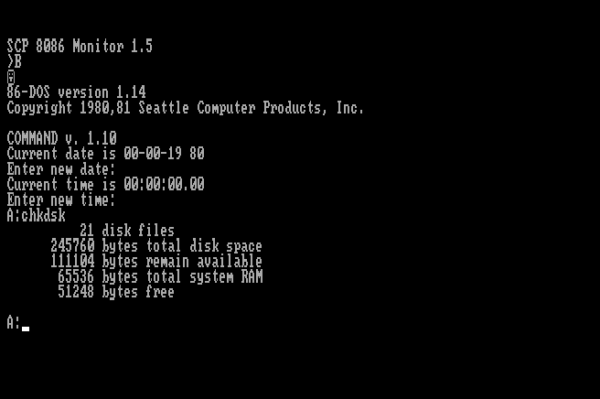Description
d6-DOS 1.14 [SCP OEM] [SCP Tarbell] (12-11-1981) (8 inch SSSD)
Get 86-DOS 1.14 for free. 86-DOS existed to increase the sales of the Seattle Computer Products 8086 computer. The only software that SCP could sell with the board was Microsoft’s Standalone Disk BASIC-86, which Microsoft had developed on a prototype of SCP’s hardware.
86-DOS 1.14 is one of the last releases of DOS by Seattle Computer Products under the name 86-DOS.
Release notes
This is the Seattle Computer Products 86-DOS “1.14” release, on which PC/MS-DOS was based. It is specifically for the 8086 SCP S-100 system with Cromemco 4FDC disk controller.
86-DOS 1.4 Changelog
Finally retired at this version of 86-DOS was distributed on a single sided 8″ floppy disk (250¼ KB). According to documents on the disk, 86-DOS no longer fits into the reserved space on the disk and is now stored in a file named 86DOS.SYS. In order for the disk to boot, 86DOS.SYS must be the first file on the disk. There are various other improvements over 86-DOS 1.00.
Interestingly, if there is no date and time stored or entered, upon boot, it will display the date as 00-00-19 80 which apparently is Sunday.
86-DOS History
86-DOS was originally developed by Seattle Computer Products (SCP) beginning in April of 1980. Firstly 86-DOS was named QDOS. QDOS Stood For (Q)uick and (D)irty (O)perating (S)ystem). However it was renamed on launch.
To Begin with it was developed to be packaged with CPM’s 8086 computer kit. SCP originally wanted to simply use Digital Research’s 8086 version of CP/M. With an uncertain release date fro the Digital Research Edition SCP made the decision to develop an OS themselves.
The programmer Tim Paterson referenced the manual for CP/M-80 while writing it which explains why CP/M and QDOS were so alike. Most Importantly Because of its similarity to CP/M, it was easy to port programs originally designed for CP/M on 8080 and Z80 processors to QDOS, which targeted 8086 processors. Moreover development of the software ended up taking only 6 weeks.

![86-DOS 1.14 [SCP OEM] [SCP Tarbell]](http://pcguys.org.uk/wp-content/uploads/2022/08/86-DOS_1.14_First_Boot-600x399.png)

![86-DOS 1.14 [SCP OEM] [SCP Tarbell]](http://i0.wp.com/pcguys.org.uk/wp-content/uploads/2022/08/86-DOS_1.14_First_Boot.png?fit=300%2C199&ssl=1)




